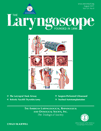Phonation threshold pressure and flow in excised human larynges†‡
Presented at the Annual Meeting of the American Laryngological Association, Chicago, Illinois, U.S.A., April 28, 2011.
Laboratory equipment was funded by the Department of Otolaryngology–Head and Neck Surgery, University of Texas Southwestern Medical Center. The participation of two authors (J.M. and K.T.W.) was supported by the University of Texas Southwestern Summer Medical Student Research Program. This work was supported by NIDCD grants R01 DC006101S1, R01 DC006101, and R01 DC005788. The content is solely the responsibility of the authors and does not necessarily represent the official views of the National Institute on Deafness and Other Communication Disorders or the National Institutes of Health. The authors have no other funding, financial relationships, or conflicts of interest to disclose.
Abstract
Objectives/Hypothesis:
To determine the phonation threshold pressure (PTP) and phonation threshold flow (PTF) in excised human larynges; determine the effects of posterior glottal width, glottal area, and gender on PTP and PTF; test the hypothesis that hysteresis is present in excised human laryngeal phonation; and compare these results to those from canine experiments and human subject measurements.
Study Design:
Induced phonation of excised human larynges in the laboratory.
Methods:
Nine human larynges were harvested within 24 hours postmortem. PTP and PTF at phonation onset and offset were measured on a bench apparatus. The effects of posterior glottal width, glottal area, and gender were examined.
Results:
Large intersubject variability was observed in PTP and PTF. PTP was comparable to those measured in vivo, whereas PTF was substantially higher. One-way ANOVA showed no significant dependence of PTP and PTF on posterior glottal width. Hysteresis was observed, with offset PTP and PTF lower than onset values. Offset measurements had significantly less variability than onset measurements (P = .012 for PTP, P = .0001 for PTF).
Conclusions:
This study is one of the first to report onset and offset PTP and PTF in fresh excised human larynges. The high PTF observed likely reflects a large direct current flow component due to vocal fold bowing. Offset PTP and PTF values may be intrinsically more reliably measured than onset values. The large intersubject variability in PTP and PTF may have implication for the clinical application of these aerodynamic parameters of phonation.




